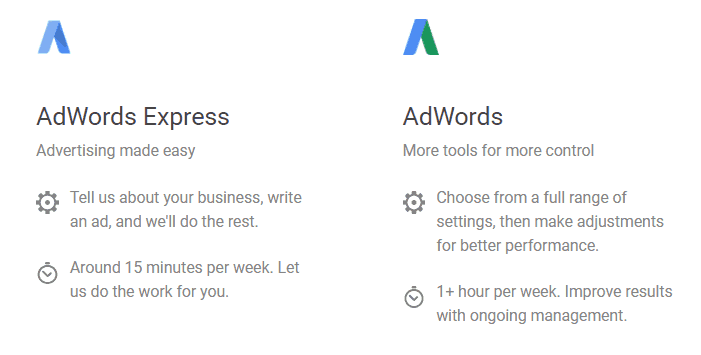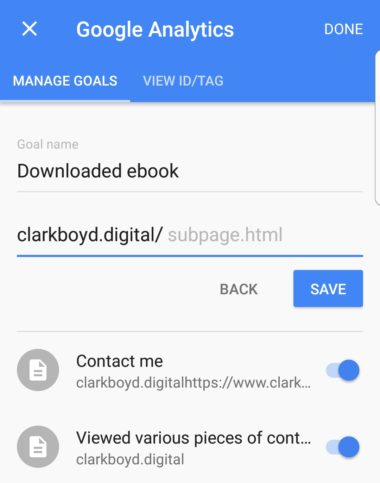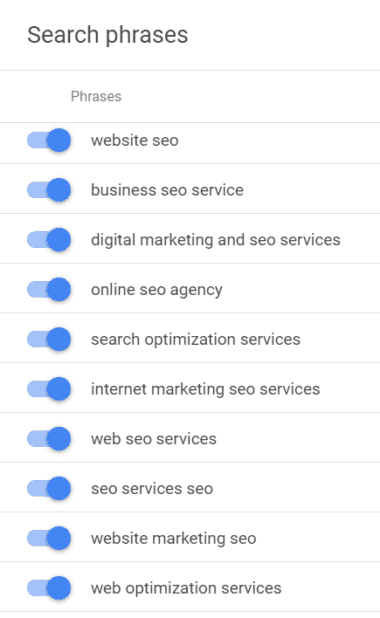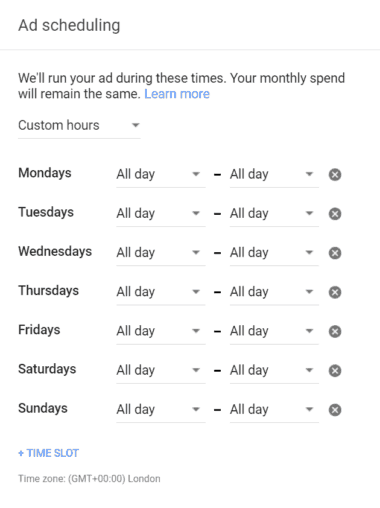Originally launched in 2011, AdWords Express (AWE) set out to provide an accessible entry to pay-per-click (PPC) advertising for small businesses.
The target market is the large number of merchants who may not have the expertise or the time to invest in an advanced AdWords campaign. Moreover, they often don’t need the complex features AdWords offers in order to hit their business goals.
It’s a seductive sell from Google, too: just enter a few details and let the technology do the hard work.
In its earliest form, merchants only needed a Google My Business (GMB) page to get started. Even those without a website could start advertising their local business online, so long as they had a GMB account.
Since then, Google has added some features to allow advertisers control over which keywords their ads show against, along with important additions such as ad scheduling and improved geotargeting.
Nonetheless, AWE remains a stripped-back version of AdWords that gets business owners up and running in just a few minutes.
In theory, AdWords Express, therefore, provides a suitably streamlined platform for time-poor small business owners.
There are just a few steps to set it up:
- Choose your business category
- Create an ad
- Choose your target locations
- Set your daily/monthly budget
In practice, that simplicity can be a hindrance to performance. AdWords is so effective due to the options it provides to marketers, after all.
As a result, AdWords Express still needs to be used judiciously in order to achieve the positive ROI we’re accustomed to through the main AdWords interface.

However, if you know what AdWords Express can and can’t do, it can be a great way to generate revenue.
The 10 tips below should help you get up and running with a successful AdWords Express campaign.
1. Start with a Small Budget
Perhaps the most important tip for those new to AdWords Express is to begin with a small monthly budget of about $300 or less.
The platform is much simpler than AdWords, but there are still some levers you can pull to affect campaign performance.
Left unchecked, Google can quickly spend your budget through the use of automated bidding, broad match keywords, or irrelevant search queries.
Each of these areas should be taken into account.
First of all, there is limited visibility over bids within AWE and your ads can appear either in traditional Google search results or on Google Maps. It is worth taking stock of early performance while your budgets remain low to see where your ads tend to perform best.
Of course, more data will allow for more comprehensive conclusions, but it is still quite possible to make an early call on when the spend is not justified by the returns.
AWE uses broad match as its keyword match type, which means your ad can show up for a wide variety of search queries related to your products and services. As a result, this can also waste some campaign budget.
Keeping your investment low allows you to take stock of how this affects your returns without taking too much of a hit.
2. Link Google AdWords Express & Analytics
If you already have a Google Analytics account set up, link it to AdWords Express.
This allows you to set campaign goals within AWE that contribute to your business objectives in Google Analytics.
In addition, it allows for a much clearer view of how profitable your paid search campaigns are in relation to the metrics that matter.
Merchants can target their campaigns to attract clicks, calls or on-site actions, and you only pay each time a customer clicks your ad.
Google provides a step-by-step guide for linking Analytics to AWE here.

3. Ask Questions
It is in Google’s best interests to make sure we all feel comfortable using AdWords Express.
The better our experience is, the more likely we are to keep spending.
Therefore, we have access to a wide variety of resources to help us through any issues we encounter.
Within AWE, there is a Help box in the top right corner and advertisers can search through the most common questions to find their answer.
The level of support is significantly lower than what you would receive as an AdWords customer, but AWE still provides enough information to resolve most issues. All you have to do is ask.

4. Learn About Quality Score
Even though AWE promises the AdWords benefits without the complexity, some AdWords knowledge can go a long way towards improving campaign performance.
Perhaps the most important of these elements is quality score.
Quality score is a fundamental aspect of paid search marketing, as it goes a long way towards deciding what you pay for each click and where your ads appear in search results.
Crafting compelling ad copy is essential, but Google wants to ensure that the user experience matches expectations when consumers arrive on the site. Quality score, which ranges from 1 to 10 (1 is low, 10 high), is Google’s enduring metric to help achieve this.
Although AWE does not bring quality score to the foreground in the same manner as AdWords, its significance in the background remains the same.
Focus on the following areas to improve the customer experience and, as a natural byproduct, your quality score, too:
- Optimize for a high CTR by writing attractive ad copy.
- Ensure that your landing pages are relevant to the ads you are displaying.
- Improve your on-site experience to engage consumers once they click through to the site.
5. Get Granular with Your Keywords
Once you select your business category in AWE, Google will automatically generate a lengthy list of keywords that it deems to be related to your business type.
It is important to review this list in detail to see which terms you feel are particularly relevant, as you should incorporate these terms into your ad copy.
This will increase the probability of consumers clicking through on your ad when they search for those business-critical phrases.

6. Switch Off Irrelevant Keywords
AWE now offers the (very welcome) option to switch off some of Google’s suggested keywords. This can make a huge difference, as Google’s initial list will contain some irrelevant terms.
Showing up for these keywords can be costly; consumers may click on your ad, which will, of course, cost you money each time they do so.
Conversely, a poor click-through rate can negatively impact your quality score and lead to higher costs for your more important keywords.
As an initial step, you can remove the keywords that you know are irrelevant before starting your campaign. Test some of those that are tangentially related to your products and services, but if they perform poorly it is best to switch these off, too.
7. Use Geotargeting & Ad Scheduling
Businesses can use the AWE platform to restrict their ad placements to within a 5-mile radius of their store locations.
There is also the option to target any geographic area worldwide, for companies that want to expand their reach to beyond their own city or state.
Setting these parameters correctly can be the difference between success and failure on AdWords Express.
This should be considered in tandem with ad scheduling, which allows marketers to define exactly when they want their ads to show.
A restaurant, for example, may only want to promote certain locations at certain times. By using geotargeting and ad scheduling, they can control their search presence to hone in on the most profitable contexts.

8. Enable Call Reporting
As more consumers use mobile devices to make purchases, it has become essential for marketers to track this activity.
For businesses with a local presence, this often means understanding how advertising affects the quantity of calls received.
AdWords Express offers the opportunity to track this through verified calls.
There is a simple option during the ad copy creation process (marked ‘Add call clicks’).
Once selected, Google will automatically insert free call-tracking numbers into your ads.
As a result, business owners can view their performance via both clicks and calls within their dashboard.

9. Download the App
The AdWords Express app, available for both Android and iOS, is a helpful complement to the desktop platform.
You can check in on campaign performance throughout the day and receive notifications when there are anomalies in your account.
The app provides all the same functionality as the desktop experience, so it is an intuitive and simple way to make campaign changes on the go.
10. Use AdWords for More Advanced Features
It is highly recommended that advertisers use either AdWords or AdWords Express, but not both at the same time.
If you use both simultaneously you can end up effectively bidding against yourself, with both ads entering the same auction for the same search query.
For all of its worth as an entry-level platform, there is no denying that AWE misses out on the advanced features that AdWords can offer.
The key is for marketers to understand when the balance is starting to tip in favor of AdWords.
AWE allows seamless campaign set-up, some important levers to aid performance, and a slick dashboard to monitor performance.
As budgets grow, marketers may start to crave the more sophisticated controls and options (such as sitelinks and device-level bidding) that AdWords provides as standard.
AdWords requires more effort and time but can produce significantly better results than AWE.
However, for businesses with a small budget looking to dip their toes in the PPC waters, AdWords Express can be a profitable platform.
Following the tips outlined above should help to maximize campaign returns.
More Paid Search Resources Here:
Featured Image: Created by Clark Boyd via Canva, November 2017.
In-post Photo: Google
Screenshots by Clark Boyd. Taken November 2017.
This content was originally published here.